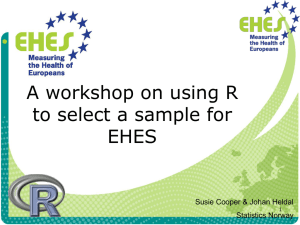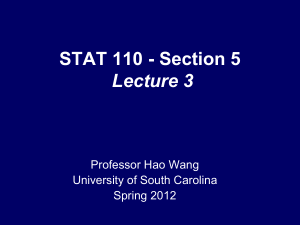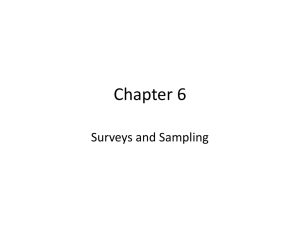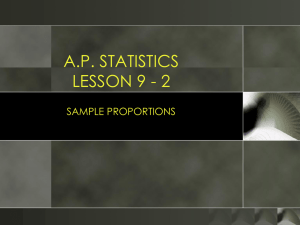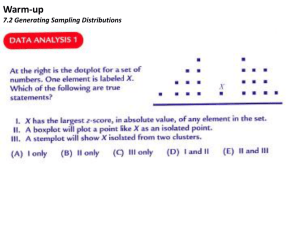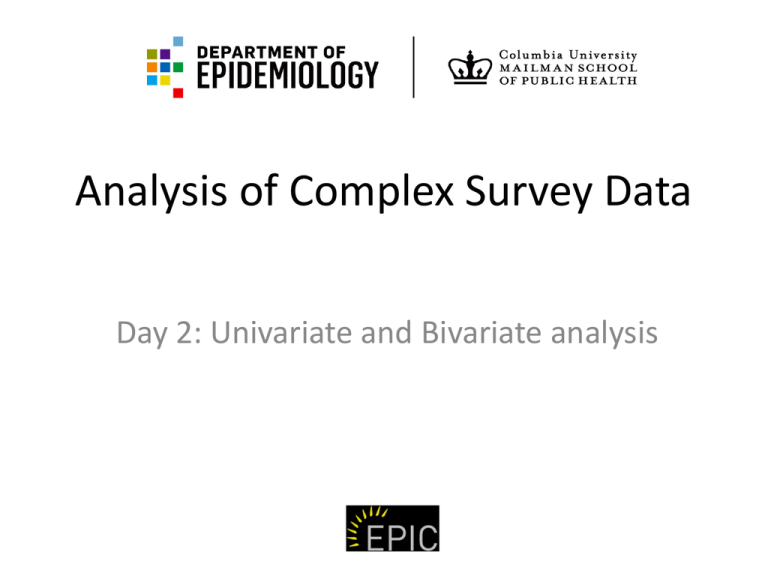
Analysis of Complex Survey Data
Day 2: Univariate and Bivariate analysis
Today’s schedule
• Part I: Introduction to SUDAAN
– Specifying the study design and design options
• PART II: Introduction to
– PROC RECORDS
– PROC CROSSTAB
– PROC DESCRIPT
SUDAAN
• Developed by RTI (Research Triangle Institute) in the
1970s to deal with complex survey data (no statistical
software packages at the time could do this)
• Although originally introduced for statistical analysis of
sample survey data from stratified, multi-stage cluster
samples, SUDAAN applies directly to the analysis of
clustered efficacy and safety data from clinical trials,
toxicology studies, and epidemiology studies.
• Now in it’s 10th version
– New to Version 10: SUDAAN has procedures that can
compute sample weight adjustments (e.g., nonresponse
and post-stratification) and can perform imputation with a
weighted sequential hot deck approach.
Some datasets that I have worked with
and others that I know about
• NESARC (http://aspe.hhs.gov/hsp/06/catalog-ai-anna/nesarc.htm)
• Monitoring the Future (http://monitoringthefuture.org/)
• AddHealth (http://www.cpc.unc.edu/projects/addhealth)
• NLSY (http://www.bls.gov/nls/nlsy79.htm)
• PSID (http://psidonline.isr.umich.edu/)
• BRFSS (http://www.cdc.gov/BRFSS/)
• NHSDUH (https://nsduhweb.rti.org/)
• Collaborative Psych Epi Surveys
(http://www.icpsr.umich.edu/icpsrweb/CPES/)
SUDAAN Statements
• Procedures statements (PROC), which define the
procedure you are asking SUDAAN to run
• Sample design statements, which tell SUDAAN
how to compute standard errors
• Procedure definition statements, which tell
SUDAAN what sort of analysis is desired
• Computation statements, which tell SUDAAN
what to compute
• Output statements, which tell SUDAAN how to
display results in printed tables and how to save
the results for further processing.
Specifying your study design
• The choice of study design in SUDAAN is very
important when analyzing correlated data. It
is only through the correct study design choice
that you will compute correct standard errors.
How does SUDAAN estimate standard
errors?
• Taylor series linearization (equivalent to GEE
in regression procedures) or replication
methods (BRR – Balanced Repeated
Replication - and Jackknife) for robust variance
estimation of descriptive statistics and
regression parameters
– Most design options will use TSL
• I will not go through details on TSL, but for
further reading go to: Tepping 1968, Kish and Frankel
1974, Folsom 1974, Shah et al. 1977, Woodruff 1971, Binder 1983
Specifying your study design
• If no design is selected, the With Replacement
(WR) design will be assumed.
• Options include:
Specifying your study design
With Replacement options
• DESIGN=WR
• Sampling with replacement at the first stage (or with small sampling
fractions) in every first-stage stratum. The sampling fraction in a
first-stage stratum is the number of primary sampling units (PSUs)
selected into the sample divided by the proportion number of PSUs
in a stratum.
• Sampling with or without replacement at subsequent stages
• Sampling with equal or unequal probabilities of selection at both
the first and subsequent stages
• The design is valid when the PSUs are independent
• In the absence of complete design information, the WR design is
often chosen to approximate variances for more complicated
designs.
Equal versus unequal selection
probabilities?
• For most surveys, each PSU has an equal
probability of selection within each stratum.
However, there may be cases in which selection
probabilities are unequal.
• For example, lower selection probabilities may be
assigned to units with higher data collection costs
and higher selection probabilities to PSUs from
small subpopulations of particular interest.
• These design probabilities are a feature of the
survey design and are assumed known before
data analysis.
Specifying your study design
With Replacement options
• DESIGN=STRWR
• A single-stage design (no clustering), stratified
random sampling with replacements (or small
sampling fractions within each stratum). Equal or
unequal probabilities of selection within each
stratum. (e.g., you take a sample of students and
stratify by classroom and sex).
• DESIGN=SRS
• A single-stage design (no clustering or
stratification), simple random sampling (equal
probabilities of selection), small sampling fraction
Specifying your study design:
Without Replacement options
• Design=WOR
• Sampling without replacement at the first stage (or with large
sampling fractions in any first-stage stratum). The sampling fraction
in a first-stage stratum is the number of PSUs selected into the
sample divided by the population number of PSUs in the stratum.
• Sampling with or without replacement at subsequent stages.
• Sampling with equal probabilities of selection within each stratum
and at each stage of without replacement sampling.
** In SUDAAN, the WOR design requires knowledge of the population
counts in each stratum or PSU at each stage of without replacement
sampling. These population counts are needed because the WOR
design computes variances according to a multi-stage formula,
which computes the finite population correction factors (FPCs) at
each stage
Specifying your study design:
Without Replacement options
• DESIGN=UNEQWOR
• Sampling without replacement, with unequal
probabilities of selection at the first stage
• Sampling with equal probabilities at subsequent
stages, with or without replacement
• DESIGN=STRWOR
• A single-stage design (no clustering). Stratified
random sampling without replacement (or large
sampling fractions in at least one stratum). Equal
probabilities of selection within each stratum.
Specifying your study design:
Replication Methods
• DESIGN=JACKKNIFE,
• Alternative method to estimate variance in
“with replacement” designs – delete one PSU
(or cluster, for correlated data), weights for
the remaining PSUs in the same stratum are
adjusted to account for the deleted PSU.
• DESIGN=BRR
• When sample design is specified by a series of
replicate weights
Specifying your study design:
Summary
Specifying your study design
• SUDAAN has nine sample design statements.
Each statement has a specific purpose, and
some are used with specific design options
only.
Specifying your study design
• WEIGHT – identifies analysis weights used in computing estimates
• NEST – lists variable(s) whose values identify the design stages
Other:
• TOTCNT – lists the variable(s) whose values are the population counts at
each sampling stage (don’t need with “WR”)
• SAMCNT – lists in order the variable(s) whose values are the sample
counts at each sampling stage (optional)
• JOINTPROB – lists in order the variable(s) whose values are the single and
joint inclusion probabilities for each primary sampling unit (PSU) and each
pair of PSUs in each first-stage stratum
• REPWGT – use with BRR
• IDVAR –use with BRR
• JACKWGTS – use with JACKKNIFE
• JACKMULT – use with JACKKNIFE
Specifying your study design
• WEIGHT – identifies analysis weights used in
computing estimates
• NEST – lists variable(s) whose values identify the design
stages
Other:
• Useful NEST option:
– MISSUNIT: specifies that when only one sample unit is
encountered within a stage, the variance contribution of
that unit is estimated using the difference in that unit’s
value and the overall mean value for the population.
Specifying your study design
Two examples
Sampling without replacement,
with unequal probabilities of
selection at the first stage
Sampling with equal
probabilities
National Longitudinal Alcohol Epidemiology
Survey at subsequent
stages, with or without
replacement
The keyword _ZERO_ causes SUDAAN to generate, for every observation
(record), a variable with the value 0. The keyword _MINUS1_ causes
SUDAAN to generate, for every observation (record), a variable with the
value -1. Use _MINUS1_ as a second or subsequent TOTCNT variable name to
indicate with replacement sampling for all levels of a variable. Use _ZERO_ as
a variable name on the TOTCNT statement to denote a
stratification variable (no variance contribution from any level of a
particular variable).
A NEST variable with a corresponding TOTCNT variable of _ZERO_ is
assumed to be a stratification variable, and thus SUDAAN does not
compute the corresponding variance component. SUDAAN uses its
computed record count per stratum as the population count per stratum for
a stratification variable.
Two examples
•
proc sort data=suicidenlaes; by stratrec psuid substrec mseg; run;
proc crosstab data=suicidenlaes design=UNEQWOR ;
nest stratrec psuid substrec mseg / missunit;
totcnt _ZERO_ _ZERO_ _MINUS1_ _ZERO_; jointprob prob1 prob2;
weight wssa;
subgroup suicidecat sex agecat1 ethrace2a race native;
levels 4 2 4 5 4 2; Lists the variables whose values
are the single and joint inclusion
tables sex*suicidecat
agecat1*suicidecat
ethrace2a*suicidecat
probabilities
for each primary
native*suicidecat
; run;unit (PSU) and each
sampling
pair of PSUs in each first-stage
stratum
Two examples
• National Epidemiologic Survey on Alcohol and Related Conditions
proc sort DATA=suicidenesarc; by stratum psu; run;
PROC CROSSTAB DESIGN=WR DATA=suicidenesarc;
NEST stratum psu / MISSUNIT;
WEIGHT weight;
Specifies that when only one
sample unit is encountered
within a stage, the variance
subgroup attempt thought felt none contribution
sex agecat1ofethrace2a
that unit israce native;
levels 2 2 2 2 2 4 5 4 2;
estimated using the
tables attempt*sex thought*sex felt*sex
none*sex
difference
in thatattempt*agecat1
unit’s value and
thought*agecat1 felt*agecat1 none*agecat1
attempt*ethrace2a
the overall mean
value for the
thought*ethrace2a felt*ethrace2a
none*ethrace2a
attempt*native
population.
thought*native felt*native none*native; run;
Part II:
PROC RECORDS and
univariate statistics
General useful options on all
procedure statements in SUDAAN
• PROC procedure_name options;
• CONF_LIM=number – change default confidence interval from 95%
to something else
• DATA=file
• DESIGN=design (e.g., “WR”)
• EST_NO=count, EST_PSU=count, and EST_STR=count – optional
statements that improve runtime efficiency
• FILETYPE=filetype (optional - in SAS-Callable SUDAAN, default is
SAS. Only options are SAS export files, SUDAAN files, and SAS files).
• INCLUDE (optional parameter that sets missing values of a variable
to be a legitimate level of all variables on the SUBGROUP and CLASS
statements.
General useful options on all
procedure statements in SUDAAN
• PROC procedure_name options;
• RECODE variable=(code_list)
•
•
•
•
•
Recode a 0,1 variable to be a 1,2 variable (very useful)
Example:
RECODE zerone= (0 1);
SUBGROUP zerone;
LEVELS 2;
•
•
•
•
Recode a continuous variable to be a 0,1 variable
Example:
RECODE X = (4.5);
All values of X less than 4.5 will be coded 0; all values of X greater than or
equal to 4.5 will be coded as 1 internally in SUDAAN.
General useful options on all
procedure statements in SUDAAN
•
•
•
•
PROC procedure_name options;
RECODE variable=(code_list);
SUBGROUP variables;
LEVELS levels;
•
Categorical variables should be declared on the ‘subgroup’ statement. The number of
categorical levels should be declared in the ‘levels’ statement.
• The values on the levels statement must correspond one-to-one, in order, to the
variables listed on the subgroup statement
Example:
SUBGROUP gender;
LEVELS 2;
Or
SUGROUP gender / INCLUDE=missing;
LEVELS 2;
General useful options on all
procedure statements in SUDAAN
•
•
•
•
•
PROC procedure_name options;
RECODE variable=(code_list);
SUBGROUP variables;
LEVELS levels;
SUBPOPN expression
Similar to a “where” statement in SAS.
e.g.,
SUBPOPN gender=1 / NAME “Men only”;
Or
SUBPOPN RACE=2 & SEX=2 & (AGE<18 | AGE>65) / NAME “African-American Females not in
the Labor Force”;
General useful options on all
procedure statements in SUDAAN
• Output statements
• PRINT statements produce a set of formatted and labeled tables that can
go by default to the .LST file in SAS-callable SUDAAN.
– SUDAAN can generate printed results in RTF format (specify FILETYPE=RTF on the
PRINT statement). When you specify FILETYPE=RTF, you must also specify
FILENAME=filename. The filename is the name of the external file that will hold
the output (should be surrounded by double quotes).
• OUTPUT statements produce an output dataset (SAS, SUDAAN, or
SUDXPORT).
• The SETENV statement is used to alter the default environment
parameters. Position the SETENV statement ahead of one or more PRINT
or OUTPUT statements. The environment it defines applies to all
subsequent PRINT or OUTPUT statements until SUDAAN encounters
another SETENV statement.
• TITLE and FOOTNOTE statements can add text before and after your
• PRINT statement tables.
General useful options on all
procedure statements in SUDAAN
• SETENV options:
PROC RECORDS
• RECORDS is a non-analytic procedure that prints
observations from the input data set, obtains the
contents of the input data set, and converts an
input data set from one type to another. You can
use the SUBPOPN statement to create a subset of
a given data se, and you can use the SORTBY
statement to sort your data.
• PROC RECORDS is particularly useful when you
wish to verify that SUDAAN is reading your data
properly.
• Similar to PROC PRINT in SAS
PROC CROSSTAB
• Computes frequencies, percentage
distributions, odds ratios, relative risks, and
their standard errors (or confidence intervals)
for cross tabulations, as well as chi-square
tests of independence and Cochran-MantelHaenszel chi-square test for stratified two-way
tables.
• Similar to PROC FREQ in SAS
PROC CROSSTAB
• Tests available in PROC CROSSTAB and when to use them:
– CHISQ (standard chi-square test, observed compared to
expected)
– LLCHISQ (tests the null hypothesis that the odds of the outcome
in the population is the same for the exposed and the
unexposed)
– CMH (Cocran Mantel Haenzel test)
– TCMH – a CMH test for trend; assumes that both row and
column variables lie on an ordinal scale (e.g., you want to
compare two Likert scales)
– ACMH – ANOVA-type CMH test; assumes that the row variable
likes on a nominal scale and the column variable lies on an
ordinal scale (e.g., do men and women differ on values of a
Likert scale)
• NOTE: when the row variable has only two levels, TCMH=ACMH.
PROC RATIO
• Computes estimates, standard errors, and
confidence limits of generalized ratios; also
computes standardized estimates and tests
single-degree-of-freedom contrasts among
levels of a categorical variable.
PROC DESCRIPT
• Computes estimates of means, totals,
proportions, percentages, geometric means,
quantiles, and their standard errors and
confidence limits; also computes standardized
estimates and tests of single degree-offreedom contrasts among levels of a
categorical variable.
• Similar to PROC MEANS or PROC UNIVARIATE
in SAS
LAB 2:
Univariate and bivariate statistics in
SUDAAN


